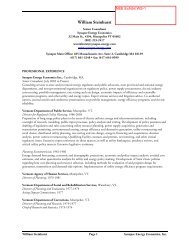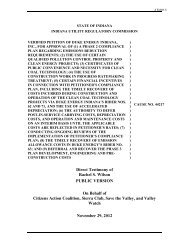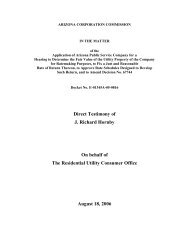Best Practices in Energy Efficiency Program Screening - Synapse ...
Best Practices in Energy Efficiency Program Screening - Synapse ...
Best Practices in Energy Efficiency Program Screening - Synapse ...
Create successful ePaper yourself
Turn your PDF publications into a flip-book with our unique Google optimized e-Paper software.
Participant-Perspective OPIs<br />
Participants <strong>in</strong> both low-<strong>in</strong>come and non-low-<strong>in</strong>come programs can realize a variety of<br />
OPIs from energy efficiency programs (NMR 2011, pp. 2-6, 5-1). These OPIs can be<br />
further divided <strong>in</strong>to the follow<strong>in</strong>g subcategories.<br />
Resource OPIs: energy efficiency can result <strong>in</strong> reduced water and/or sewage<br />
costs. Resource OPIs can also <strong>in</strong>clude heat (or lack thereof) generated by<br />
efficient equipment, as well as other fuel sav<strong>in</strong>gs or costs (NMR 2011; SERA<br />
2010).<br />
Equipment OPIs: participants often experience efficient equipment perform<strong>in</strong>g<br />
better than previous or <strong>in</strong>efficient equipment, result<strong>in</strong>g <strong>in</strong> reduced (or <strong>in</strong>creased)<br />
ma<strong>in</strong>tenance costs, improved light<strong>in</strong>g quality, etc. (NMR 2011, pp. 5-13 – 5-15;<br />
SERA 2010).<br />
Property value: <strong>in</strong>creased property value is frequently recognized as an OPI<br />
associated with program participation. The benefit of <strong>in</strong>creased property value<br />
has been estimated through the value of anticipated ease of sell<strong>in</strong>g or rent<strong>in</strong>g, or<br />
<strong>in</strong> some cases, <strong>in</strong>creased resale or rental value. The improved durability and<br />
reduced ma<strong>in</strong>tenance for the home is also taken <strong>in</strong>to consideration (NMR 2011,<br />
p.5-16; SERA 2010). 20<br />
Comfort: participants <strong>in</strong> energy efficiency programs commonly experience<br />
greater perceived comfort, either due to fewer drafts and more steady<br />
temperatures with HVAC equipment, or reduced noise from better equipment.<br />
Improved (or worsened) aesthetics can also be considered comfort OPI (NMR<br />
2011, p.5-9; SERA 2010).<br />
Health and safety: energy efficiency programs may have direct impacts on health<br />
through improved home environments, reduced exposure to hypothermia or<br />
hyperthermia – particularly dur<strong>in</strong>g heat waves and cold spells – improved <strong>in</strong>door<br />
air quality, and potential reductions <strong>in</strong> moisture and mold, lead<strong>in</strong>g to amelioration<br />
of asthma triggers and other respiratory ailments. Reduced <strong>in</strong>cidence of fire and<br />
carbon monoxide exposure are also commonly identified as safety-related<br />
benefits result<strong>in</strong>g from weatherization. Safety is also improved from better, more<br />
durable light<strong>in</strong>g equipment (NMR 2011, pp.5-30 – 5-34; SERA 2010; NZ EEAC<br />
2012).<br />
OPIs for owners of low-<strong>in</strong>come rental hous<strong>in</strong>g: 21 OPIs can accrue to owners of<br />
low-<strong>in</strong>come rental properties, <strong>in</strong>clud<strong>in</strong>g marketability/ease of f<strong>in</strong>d<strong>in</strong>g renters,<br />
reduced tenant turnover, <strong>in</strong>crease <strong>in</strong> property value, equipment ma<strong>in</strong>tenance for<br />
heat<strong>in</strong>g and cool<strong>in</strong>g systems, reduced ma<strong>in</strong>tenance for light<strong>in</strong>g, durability of<br />
property, and reduced tenant compla<strong>in</strong>ts (NMR 2011, pp.1-8, 7-1).<br />
20 While <strong>in</strong>creased property value is frequently cited as a significant benefit of home energy retrofit<br />
programs, some parties argue that the <strong>in</strong>creased property value is primarily a function of the reduced<br />
utility bills and that to <strong>in</strong>clude both would be double-count<strong>in</strong>g. We <strong>in</strong>clude this item <strong>in</strong> our list <strong>in</strong> order to<br />
be comprehensive, but caution that the property value NEI should only <strong>in</strong>clude those changes <strong>in</strong> property<br />
value that are not accounted for <strong>in</strong> the other categories of energy efficiency benefits.<br />
21 It is important to ensure that any impacts <strong>in</strong>cluded <strong>in</strong> this category are not double-count<strong>in</strong>g the impacts <strong>in</strong><br />
other categories listed here (e.g., reduced ma<strong>in</strong>tenance, <strong>in</strong>creased property value).<br />
| 34 <strong>Best</strong> <strong>Practices</strong> <strong>in</strong> <strong>Energy</strong> <strong>Efficiency</strong> <strong>Program</strong> Screen<strong>in</strong>g | www.nhpci.org







